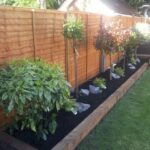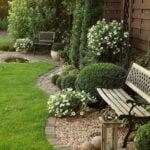Are you looking for herb garden design layout ideas to create a beautiful and functional green space in your backyard? The layout of your herb garden plays a crucial role in the growth and overall aesthetics of your plants.
In this article, we will explore the importance of herb garden design and provide you with tips and inspiration to create the perfect layout for your herbs. Whether you’re a novice gardener or have years of experience, these ideas will help you plan and implement a well-designed herb garden that suits your needs.
A well-designed herb garden not only adds beauty to your outdoor space but also provides numerous benefits. From easy access to fresh herbs for cooking to creating a welcoming habitat for pollinators, a thoughtfully planned layout can enhance the functionality and appeal of your garden. We’ll discuss the impact of proper herb garden layout on plant growth and how it contributes to the overall success of your gardening venture.
When planning your herb garden design, there are several factors to consider, including sunlight, soil type, and accessibility. Choosing the right location for your herb garden is essential for its long-term health and productivity.
We’ll provide you with practical tips for selecting an ideal spot based on these factors and mapping out a layout that maximizes the potential of your herbs. So let’s dive into the world of herb garden design layout ideas and transform your outdoor space into a thriving oasis of aromatic herbs.
Planning Your Herb Garden Design
When planning the design for your herb garden, there are several important factors to consider in order to ensure the success and longevity of your garden. One of the first steps is choosing the right location for your herb garden. Most herbs thrive in well-drained soil and require plenty of sunlight, so finding a spot that meets these criteria is essential.
Another crucial consideration when mapping out your herb garden layout is accessibility. You’ll want to make sure that your herbs are easily accessible for watering, weeding, and harvesting. It’s also important to think about how you will navigate through the garden as you work on it.
Lastly, don’t forget to take into account the type of soil you have in your chosen location. Different types of herbs may have different soil requirements, so be sure to do some research on what types of soil each herb prefers before finalizing your herb garden layout.
| Planning Factors | Considerations |
|---|---|
| Location | Sunlight, drainage |
| Accessibility | Watering, weeding, harvesting |
| Soil Type | Different requirements for different herbs |
Types of Herb Garden Layouts
When it comes to planning your herb garden layout, there are several different options to consider. Each layout has its own unique advantages and challenges, so it’s important to choose the one that best suits your space and needs. Below are some common types of herb garden layouts:
- Traditional Rows: This classic layout consists of straight rows of herbs planted in the ground. It is a simple and practical option for larger herb gardens, allowing for easy access and maintenance.
- Spiral Designs: Spiral herb gardens are not only visually appealing but also serve a functional purpose. The spiral design creates varying microclimates for different types of herbs, offering ideal growing conditions for each plant.
- Raised Beds: Raised bed herb gardens provide excellent drainage and allow for better control over soil quality. They are also easier to maintain and harvest, making them a popular choice for many gardeners.
- Container Gardens: Perfect for small spaces or urban settings, container herb gardens offer the flexibility of being able to move the plants as needed for sunlight or protection from weather conditions.
Each type of herb garden layout has its own set of pros and cons, so it’s important to weigh these factors when deciding which one is right for you. Consider your available space, gardening goals, and personal preferences when choosing the layout that will work best for your herb garden.
Ultimately, the best herb garden layout is one that fits your needs and lifestyle while promoting healthy plant growth. Experiment with different layouts or even combine elements from various designs to create a unique and functional herb garden that you can enjoy for years to come.
Designing an Aesthetic Herb Garden
When designing an aesthetic herb garden, there are several key elements to consider in order to create a visually appealing layout. Incorporating these design features can enhance the overall look of your herb garden and provide a beautiful and functional space for growing herbs. Here are some tips for creating an aesthetically pleasing herb garden layout:
- Pathways: Incorporating pathways into your herb garden not only adds visual interest but also provides practical access to your plants. You can use materials such as gravel, stepping stones, or brick to create defined pathways that both guide the eye and allow for easy navigation through the garden.
- Borders: Adding borders around your herb garden beds can help define and organize the space, as well as add a decorative element to the overall design. Consider using natural materials like rocks or wood for a rustic look, or opt for more formal borders made from concrete or metal for a sleeker design.
- Decorative Features: Including decorative elements such as statues, birdbaths, or ornamental containers can elevate the aesthetic appeal of your herb garden. These features not only add visual interest but also provide focal points within the garden that draw the eye and create a sense of atmosphere.
In addition to these design elements, it’s important to consider the overall cohesion and balance of your herb garden layout. By strategically arranging different types of herbs and integrating complementary colors, textures, and heights, you can create a harmonious and visually captivating display in your herb garden.
Ultimately, designing an aesthetic herb garden is about creating a space that is both beautiful and functional. By incorporating pathways, borders, decorative features, and thoughtful plant arrangements into your layout, you can transform your herb garden into a visually stunning oasis that enhances the natural beauty of your herbs while providing an inviting space for relaxation and enjoyment.
Maximizing Space in Small Herb Gardens
When it comes to designing an herb garden, space can sometimes be a limiting factor. However, with a bit of creativity and strategic planning, it’s possible to maximize even the smallest of garden areas for growing herbs.
Vertical Gardening
One effective way to save space in a small herb garden is through vertical gardening. By utilizing walls, fences, or trellises, you can grow herbs upwards rather than outwards. Vertical planters and hanging containers are also great options for maximizing space while still allowing your herbs to thrive.
Companion Planting
Another space-saving technique is companion planting, which involves growing different plants together for mutual benefit. In the case of herb gardens, certain herbs can be planted alongside each other to create a harmonious and efficient use of space. For example, planting taller herbs like rosemary or basil alongside lower-growing herbs like thyme or oregano can help optimize space without overcrowding individual plants.
Utilizing Containers
In small herb gardens, utilizing containers is an excellent way to make the most of limited space. Whether it’s traditional terra cotta pots, hanging baskets, or window boxes, growing herbs in containers allows for flexibility and mobility. It also enables you to position your herbs in the best possible sunlight and easily rearrange them as needed. Additionally, container gardening minimizes weed growth and makes maintenance more manageable in compact spaces.
By incorporating these space-maximizing techniques into your small herb garden layout, you can create a functional and bountiful herb garden regardless of size constraints. Whether it’s through vertical gardening, companion planting, or container gardening – there are plenty of opportunities to grow a diverse array of herbs in even the most limited spaces.
Herb Garden Design for Specific Uses
When it comes to designing an herb garden, there are countless possibilities depending on the specific use you have in mind. Herb gardens can be tailored to suit culinary needs, medicinal purposes, fragrance, and even attracting wildlife. By creating a layout that caters to your intended use, you can maximize the functionality and benefits of your herb garden.
For culinary use, consider planting popular cooking herbs such as basil, rosemary, thyme, and cilantro. When designing the layout for a culinary herb garden, it’s essential to ensure easy access to these herbs from the kitchen. Consider placing the herb garden near your cooking area or creating designated sections for different types of herbs for easy navigation. Additionally, incorporating labels or signs for each herb can help identify and differentiate between them.
On the other hand, if you’re interested in using your herb garden for medicinal purposes, focus on planting herbs known for their healing properties. Herbs like chamomile, lavender, peppermint, and echinacea are commonly used in natural remedies. When designing the layout for a medicinal herb garden, consider grouping similar herbs together based on their healing properties. You may also want to allocate more space to those herbs that you plan on using frequently.
For those interested in creating an herb garden for fragrance or wildlife attraction, think about selecting an array of aromatic herbs such as lavender, mint, lemon balm or bee balm. Grouping these fragrant herbs together can create a delightful sensory experience within your garden space while also attracting beneficial insects and pollinators.
When designing the layout for this type of herb garden, consider blending various heights and textures of plants to create a visually appealing and inviting environment for both humans and wildlife alike.
Overall, regardless of the specific use of your herb garden design layout – whether it’s culinary, medicinal, fragrance-focused or wildlife-attracting – always keep in mind that proper maintenance is key to ensuring ongoing success. With regular care and attention given to your herbal layouts according to their unique purposes will surely yield abundant rewards in terms of health benefits and visual appeal alike.
Maintaining Your Herb Garden Layout
The Importance of Ongoing Maintenance
Once you have carefully planned and implemented your herb garden layout, it is crucial to prioritize ongoing maintenance to preserve the health and aesthetics of your plants. Regular maintenance not only ensures that your herbs thrive, but also helps in sustaining the overall layout of your garden. This includes the upkeep of pathways, borders, and other design elements that contribute to the visual appeal of your herb garden.
Tips for Preserving Your Layout
To maintain the intended layout of your herb garden, it is important to regularly prune and harvest your herbs to prevent overcrowding and promote healthy growth. Additionally, keep an eye out for any signs of disease or pests, as early intervention can help protect the integrity of your garden layout. Remember to also periodically replenish mulch, fertilize the soil as needed, and make any necessary adjustments based on plant growth and changing environmental conditions.
Making Adjustments as Needed
As time goes on, you may find that certain elements of your herb garden layout need adjustments. This could be due to changes in plant growth patterns, alterations in sunlight exposure, or simply a desire to refresh the design. Be open to making these changes while keeping the original intent of the layout in mind.
Consider incorporating new decorative features or rearranging existing plantings to keep your herb garden looking fresh and vibrant. By staying attentive to these details and being proactive in maintenance, you can ensure that your well-designed herb garden layout continues to flourish for years to come.
Inspiration for Your Herb Garden Design Layout
When it comes to designing your herb garden layout, drawing inspiration from real-life examples can be incredibly helpful. Seeing how others have creatively arranged their herb gardens can spark ideas for your own design and help you envision the possibilities for your space. There are numerous beautifully designed herb gardens that showcase a wide range of layouts and styles, each with its unique charm and functionality.
One source of inspiration for your herb garden design layout is to visit botanical gardens or public gardens in your area. These spaces often feature carefully curated herb gardens that demonstrate different layouts, planting combinations, and decorative elements. Take note of which designs appeal to you the most and consider how you might adapt similar features to fit your own space.
Another way to find inspiration for your herb garden design layout is by exploring online resources and social media platforms. Many gardening enthusiasts share photos and videos of their own herb gardens, offering a glimpse into how they have organized their plants and utilized various design elements. You may come across innovative ideas or creative solutions that resonate with your vision for your own herb garden.
Conclusion
In conclusion, designing a well-planned herb garden layout is essential for achieving both visual appeal and the optimum growth of your herbs. The careful consideration of factors such as location, sunlight, soil type, and accessibility will greatly impact the success of your herb garden.
Whether you opt for traditional rows, spiral designs, raised beds, or container gardens, each layout comes with its own set of pros and cons to consider. Additionally, incorporating aesthetic elements such as pathways, borders, and decorative features can elevate the overall design of your herb garden.
Furthermore, even in limited spaces, there are creative ways to maximize space for your herb garden through vertical gardening and companion planting techniques. It is also important to customize your herb garden layout based on its specific use – whether it be culinary, medicinal, fragrance or wildlife attraction. Maintenance is a crucial aspect of preserving the intended layout of your herb garden and making adjustments as needed.
As you venture into planning and implementing your own herb garden design layout, remember that there are endless possibilities for creating a beautiful and functional space for growing herbs. By taking inspiration from real-life examples and exploring additional resources available to you, you can embark on a rewarding journey that not only enhances the beauty of your outdoor space but also provides you with an abundant supply of fresh herbs for various purposes.
So go ahead and start designing – your very own herb garden awaits.
Frequently Asked Questions
What Is the Best Layout for an Herb Garden?
The best layout for an herb garden is one that takes into consideration the needs of each herb, such as sunlight, water, and space. Typically, herbs are grouped together based on their similar needs, so it’s important to plan the layout with this in mind.
Some commonly used layouts for herb gardens include circular, square, or rectangular designs to help maximize space and accessibility.
How Do You Arrange Herbs in a Herb Garden?
When arranging herbs in a garden, it’s important to consider their individual growth habits and requirements. Taller herbs should be planted at the back of the garden to prevent them from shading shorter ones.
It’s also helpful to group together herbs with similar watering needs to make maintenance easier. Additionally, consider planting perennial herbs in a location where they won’t be disturbed as they continue growing year after year.
What Herbs Grow Well Together Chart?
While there isn’t a strict “herbs grow well together chart,” there are general guidelines that can help determine which herbs are compatible for planting alongside each other. For example, dill and cilantro can inhibit the growth of carrots when planted together, so it’s best to keep them separate.
Some combinations like basil and tomatoes or chamomile and thyme have been known to benefit each other’s growth when planted close by. Doing some research on specific herb combinations before planning your garden can help ensure success.

Welcome to my gardening blog! I am passionate about plants and enjoy sharing my knowledge and experiences with others. In this blog, I will write about everything related to gardening, from tips on how to get started to updates on my own garden projects.





